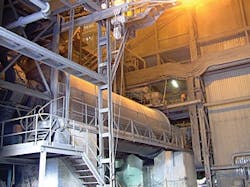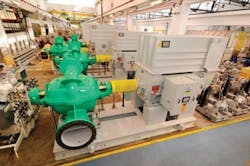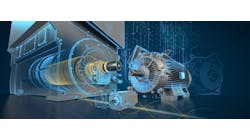Check Out Montague's Google+ profile.
Entirely new inventions may be dramatic, but they're rare. Reinventions or ongoing refinements of already familiar technologies aren't as exciting, but they're far more frequent, so they likely result in greater total gains in performance and production. Likewise, while motors and drives may be everywhere in process applications and elsewhere, the fact that they're so long established shouldn't be an obstacle to improving them and their applications. They may be ubiquitous, but aided by variable-speed and variable-frequency drives (VSDs and VFDs) and other recent innovations, motors can instead be opportunities to achieve gains in many settings.Speed Control Aids Quality
For instance, the PPC Jupiter plant of Pretoria Portland Cement Co., Ltd. recently improved the consistency and quality of its products by using VSDs and more accurate controls on the bucket elevators feeding and receiving new and recycled cement at its mills (Figure 1). PPC is the South Africa's leading cement supplier with eight plants and three mills in South Africa, Botswana and Zimbabwe.
Read Also: Motor drives "hunt" for success
Likewise, Mine Los Colorados iron ore mine in Chile recently added an ACS 1000 medium-voltage VSD from ABB to increase speed by 25%, and bring its conveyor up to nominal throughput without replacing its existing gearbox and 400-kW motor. The mine is operated by CAP Mineria-Compañia Minera del Pacifico S.A. (CMP) in Santiago, Chile.
The conveyor lifts material from the mine's stockpile to a train platform, but the existing gearbox and motor weren't running at the required speed above 50 Hz. The ACS 1000 enabled the motor and gearbox to soft start, ramp up smoothly, and run at 63 Hz. The drive's sinusoidal output voltage also allowed the motor to be used without derating, so the more than 100-meter cable length between the drive and motors was not a problem. Finally, the VSD meant the conveyor's hydraulic coupling was no longer needed, which simplified its layout and improved availability and efficiency.
Serving Specialized Settings
Perhaps the main benefit of advances in motor and drive technologies is that they can be deployed in settings where they haven't ventured before, or be more effective in applications where they've been hard to apply.
For example, Petrobras' Abreu e Lima refinery in Ipojuca, Pernambuco, Brazil, just installed 11 three-phase induction motors from WEG suitable for explosive atmospheres to drive the centrifugal pumps from KSB feeding water into the cooling towers associated with the refinery's main steam turbines (Figure 2). The pumps will provide water for circulation and cooling the plant's equipment, which is critically important in the refining process.
Read Also: Choosing motor controls and drives
Standards + Power Density = Efficiency
Beyond improved control from VFDs and VSDs, motors are also being pushed by government standards and user demands to achieve greater power density and efficiency, which is often achieved by integrating permanent magnets (PMs) made from rare earth materials.
"Increases in motor efficiency are driven mostly by government efficiency regulations, such as the Energy Policy Act (EPAct) and the Energy Independence and Security Act (EISA), and by end-user demands for reduced total cost of ownership," says Sam Harris, business manager for large drive technologies at Siemens Industry. "The recent introduction of die-cast copper rotors by Siemens and a few other motor manufacturers have yielded higher efficiencies than mandated by the present EISA."
Steve Evon, engineering manager for variable-speed and custom medium-AC motors at Baldor Electric Co., a member of ABB Group, reports that DoE is working on a follow-up to EISA that will require even more efficient motors, perhaps by 2015, and add frame sizes beyond the 200-hp and less motors it covers now, requiring builders to further optimize motor redesigns with finite analysis tools and better models to identify power losses more easily. "We're still using aluminum rotors with copper windings, but now we're using punched lamination stacks, such as our RPM AC line, which are thinner and easier to cool, and don't need the usual cast iron frame, so they allow more room for active components," says Evon.
"We've really reached the physical limit of how much wire we can get into our winding slots, which is why PM and synchronous reluctance motors are so popular. The key to the future is finding lower-cost magnetic materials."
Cooperating with Upper Levels
Drives and motors are also learning to communicate and better coordinate efforts with related programmable logic controllers (PLCs) and other supervisory systems. For instance, to provide balanced dewatering and remote monitoring and control in natural gas production, system integrator and machine designer Atfab LLC in West Branch, Tenn., recently worked with Schneider Electric (www.schneider-electric.com) to construct an automated, condition-based pump jack that combines Schneider's Altivar 312 VFD, Twido PLC and Megelis HMIs. Atfab and Schneider also developed software that calculates how long the pump jack should run based on site conditions, and shuts it down, instead of running for a set time that isn't always optimal.
"Some wells showed more than a 50% energy savings from not having to run in a time mode," explains Jeff Thornburg, Atfab's operations manager. "We also engineered this solution to allow the pump jacks to operate using three-phase motors instead of a single-phase mode, which garnered added energy savings and maintenance costs by eliminating the capacitive starts. The best part is that an algorithm in the PLC allows the pump jack to learn from itself, and make adjustments based on the unique characteristics of the well it's controlling."








